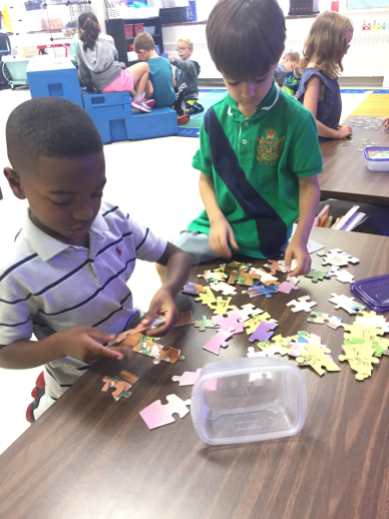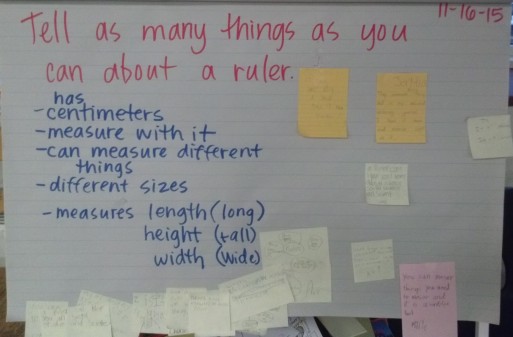Like I mentioned in our first post about our first day in first grade, we’ve been busy, as there are LOTS of new things to learn at the beginning of the year. Any year really, but especially in first grade! This post is about something every important around our classroom and our school–GRIT!
You might already know about how we have a Robinson Mindset that we have learned and use, and that we start everyday with together. One really important part of it is: I have grit! In fact, it’s so important it’s the first line!

So…knowing how important this idea is, we have to make mighty sure that kiddos know what it means and how they use it and get it. Most of them have at least some knowledge from kindergarten (and their super smart parents who may have already taught them about it!), and so we started there. We charted what we remembered:

Aside from just being able to talk about GREAT though we have to be able to use it, right? Pull it up from deep down inside even when things are super tricky and really hard. So next we did an activity that gave them the chance to do that–PUZZLES!!
First I talked about how I do a jigsaw puzzle everyday! I have an app on my iPad that lets you build puzzles, and has a new “puzzle of the day” each morning. It’s one of my favorite things to do, and helps keep my brain awake and active. I LOVE how it feels when you’re working a really hard puzzle and then you finally figure it out! I want kiddos to feel that same feeling, as well as realize that some things are even hard for grown-ups!

We picked partners, and also the puzzle we’d do–there were some that were 24 pieces, some that were 60, and some that were 100 pieces! After some quick directions about where to go and how you HAD TO KEEP WORKING, we got busy. As a side note, I was watching for what would happen with GRIT during this activity, but I was also collecting data on partnerships that worked well.
Some teams were able to finish their puzzle, and 1 team even got to start (and mostly finish) another one. We worked for about 20-30 minutes and then gathered to debrief. We talked about what we had learned about what helped us and what was tricky. Some of their smart strategies are the ones that I use as an adult to do my puzzles, too!
As with many things, we decided (well, actually they asked!) if we could do this whole puzzle thing again. Some said if they’d have had more time they could have finished, and some wanted to tackle the same puzzle after our conversation and try some of the new strategies they’d heard from their friends. We (Ms. Turken, who we work with ALOT now, and I) decided that this was a GREAT idea.
We planned a read aloud first, which highlighted the idea of trying new and different ideas, not giving up and working to complete your task even when it’s tricky. We read the book Stuck by Oliver Jeffers together as two first grade classes. This protocol is always fun and helpful as there are SO MANY FIRST GRADE BRAINS to learn from and different perspectives to consider.
After this book and some super creative thinking about how the boy in the story (Floyd) used his GRIT to get his kite (and then everything else he threw in the tree) unstuck, we checked out the posters our classes had made separately and noticed the similarities and differences. Many strategies were similar, but there were ideas that were specific to each one and it was great to be able to share these new ideas with everyone before they got to work again.

We had planned to use the SAME partners and do the SAME puzzle, but we did do one thing DIFFERENT: we traded teachers! This time Ms. Turken worked with Rm. 111 kiddos and I stayed to learn from/with Rm. 112 kiddos. It was an opportunity for us to get to know each other better, as well as for me to see her kids in action, perhaps seeing different things than Ms. Turken did. Being able to share new insights on our students is one of the things we’re already loving about working so closely together! Lots more friends finished puzzles this time than they did on our first go-round.
These are some Rm. 111 friends I worked with that day–look how engaged they are!
After our work time, we gathered one more time to discuss how it went, and shared things that had we had changed, things we had learned or things we had noticed.

Ms. Turken led the conversation as we shared our smart thinking! (And yes, I promise I will include more pictures of me–seems funny to see someone else’s face all over my blog! lol).
What a great day of learning, and one that we will keep coming back to for a VERY LONG TIME!!





























































 This one is related to the work we’ve been doing with The T-Shirt Factory, and would help them with the work they’d do later on with breaking up larger numbers into smaller groups.
This one is related to the work we’ve been doing with The T-Shirt Factory, and would help them with the work they’d do later on with breaking up larger numbers into smaller groups.

























